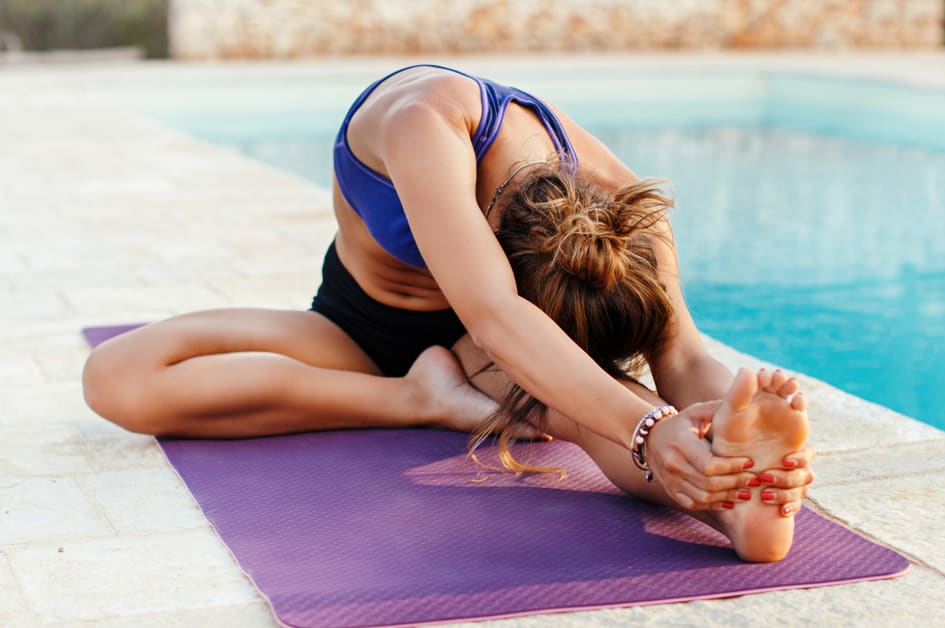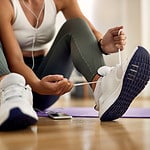Warm Up
Warm up is vital to stop overuse injuries. Stretch and make strong the muscles in the knee area. It helps to improve flexibility, range of motion and mobility. These can help reduce the risk of strain and injury.
Here we will go over the best warm up exercises for the knee:
Stretch your quads and hamstrings
Stretching and strengthening are essential for healthy knees. Whenever you feel knee pain, these exercises can help.
Start with light activities. For example, march or walk for five minutes. That warms up your muscles.
Stretch your quads and hamstrings. Stand with feet hip-width apart. Bend down and grab a towel at both ends. Raise your right leg straight behind you. Grab the towel with your right arm. Gently pull on the towel and push away with the right thigh until you feel tension. Hold this for 10-30 seconds. Do this again twice, then switch sides and repeat.
Do a dynamic warm-up
Dynamic warm-ups are exercises to increase joint movement and muscle temperature, as well as stimulate the nervous system. It gets the body ready for physical activity and enhances coordination by enabling the brain to send signals to the muscles. Dynamic warm-ups imitate certain movements for the upcoming workout session. This helps with performance and reduces post-exercise soreness.
Examples of dynamic warm-ups:
- Jogging
- Skipping
- High knees
- Lunges with a twist
- Frog hops
- Butt kicks
Dynamic warm-up before activity guards against overuse injuries, reduces muscle tension and stiffness, boosts joint range of motion, and heightens body awareness. Furthermore, dynamic stretches increase agility as they prepare the body’s nervous system for muscular activity, thus giving better coordination during any activity.
Strengthening Exercises
Keeping your knees healthy and strong? Essential! Strengthening exercises can help. They’ll improve joint stability, range of motion, muscle strength and coordination.
Here, we’ll discuss the most common knee strengthening exercises:
Lunges
Lunges are a great exercise for strength training. They activate your glutes, quads, hamstrings, and calves. Lunges also help with stability and balance around the hips.
To begin, stand with your feet hip-width apart. Step forward with one leg. Keep your core engaged and hips level. Lower down until both knees are bent at 90 degrees. Don’t let the front knee go beyond your toes. Press through the heel to return to standing. You should feel it in the glutes and quads.
To increase difficulty, add weights or hold a kettlebell or medicine ball at chest level. To add power, drive through both legs as you go down and jump back up into standing. Then switch sides.
Squats
Squats are great for strengthening your core muscles. They can help with balance, stability, and strength. You don’t need weights to do squats, just pick what level you’re at. It’s important to do them correctly to get the most benefit.
- Stand with your feet slightly wider than shoulder-width apart. Point your toes forward and spread the weight evenly. Pull in your abs for spinal stability. Lift your chest and keep your head looking forward.
- Bend at the knees until your thighs are parallel to the ground. Pause, then press yourself up again.
When working with weights, remember form is better than quantity. Start light so you can focus on technique. Master good form before increasing intensity or reps.
Step-ups
A step-up is a great way to strengthen the quads, hamstrings, and glutes. It also helps control knee movement and prevents injury. All you need is a box or bench that’s 7 to 12 inches high and something to hold onto for balance.
To do a step-up:
- Stand behind the box.
- Place one foot firmly on top of the box, with toes pointed forward and heel pressed down.
- Step up onto the box with both feet. Pause at the top. Step down with one foot.
- Alternate legs each rep. Engage abdominals to maintain balance and form.
- Begin with 2 sets of 10 reps per leg. Increase reps as ready. Rest between sets if necessary. Respect your fitness and strength level. Be cautious to protect joints from injury.
Calf Raises
Calf raises are a great way to build strength and get toned calves. This exercise works your gastrocnemius muscle in the back of your lower legs, plus some smaller muscles.
You can do them with no equipment, or use a weight bar and weights for extra resistance. There are also variations which target different muscles.
To do a basic one, stand with feet slightly staggered and shoulder-width apart. Lower down with heels close to the ground and rise up onto your toes. For more intensity, hold a weighted bar, stand on a step or curb, or use cables.
For greater variation, try:
- Split stance calf raises
- Partner assisted calf raises
- Donkey kicks
Do this routine 2-3 times per week, 3-4 sets of 8-12 reps. With that, you’ll get stronger calves!
Stretching Exercises
Stretching reguarly can increase your flexibility, range of movement and help avoid knee overuse injuries. To reduce pressure on the knee joint, it’s recommended to do exercises which strengthen and stretch the muscles around the knee.
Here are some different types of stretches you can try to protect your knees from overuse injuries:
Hamstring stretches
Hamstring stretches are awesome! They help increase flexibility in your legs and lower the risk of getting hurt while exercising. Tight hamstrings can cause pain, discomfort, and lack of mobility.
To stretch your hamstrings well, it’s important to know the anatomy of the area. The hamstrings are 3 muscles at the back of each thigh. They run from below the buttocks to above the knees. They help us bend and rotate our legs, as well as bridge up and down when we walk or run.
When stretching your hamstring muscles, it is best to do each exercise for 20 seconds, then release for 10 seconds, and repeat 2-3 times on each side. Don’t bounce or force the stretch. Do it gently, but effectively.
Examples of effective hamstring stretches are:
- Standing Forward Bend: Stand with feet shoulder-width apart. Reach down with both hands, trying to grab toes. Keep knees slightly bent if can’t grab toes fully. Over time, work on increasing the range.
- Seated Hamstring Stretch: Sit on a mat or chair with feet on the ground, toes pointed up, and knee slightly bent. Lean forward towards toes until you feel a comfortable stretch.
- Reclined Hamstring Stretch: Lay flat on your back with legs stretched out. Bend one knee, keeping heel grounded. Have a helper pull your foot up with both hands.
Quadriceps stretches
Quads are 4 larger muscles on the front of your thigh. Doing activities like running, biking and skiing can overwork them. To protect them, take time to stretch. Here are two simple stretches:
- Standing Quad Stretch: Feet hip-width apart. Bend one knee. Grab ankle with same hand. Pull heel towards buttocks. Feel a gentle stretch in the front of thigh. Hold for 20 seconds. Switch sides.
- Lying Quad Stretch: Lie with legs together and arms out in front. Bend one knee to 90 degrees. Keep foot close to buttocks. Bring heel towards head until you feel a gentle stretch. Don’t pull too hard. Hold for 20 seconds. Switch sides. Get up slowly and carefully.
Gluteal stretches
The glutes are a muscle group with three muscles – the gluteus maximus, medius, and minimus. They are big and important for your body. Stretching them regularly helps reduce tension in your back and increase mobility. Doing a few gluteal stretches every day helps keep you healthy and injury-free, as well as improving your flexibility.
Here are some easy and effective gluteal stretches to do:
- Seated fire hydrant: Sit on the floor with one leg bent and the other straight behind you. Put your hands on both sides of the bent knee. Gently press down and draw your knees apart to stretch the hip joint.
- Standing single leg lift: Stand with one foot planted and lift the other leg up behind you. Keep your hips facing forward to get the full motion.
- Clamshells: Lie on your side with bent knees. Keep feet together and slowly open both legs like a clamshell to stretch the inner thighs. Keep hips forward for best results.
Doing these stretches can help loosen tight hip muscles from sitting too long or from physical activity. Take regular breaks and fit in some stretching if you can!
Calf stretches
Calf stretches are essential for any knee strengthening routine. You may do them while standing or sitting. Concentrate on not tensing the lower leg and no bouncing. Each stretch lasts from 30-60 seconds and repeat 3 times.
- Standing calf stretch: Stand with feet shoulder-width apart and one foot in front. Put hands on the wall at shoulder height and lean until you feel a stretch in the back of your calf. Step back to increase the stretch.
- Sitting calf stretch: Sit on the floor. Legs stretched out in front, toes pointing up and feet flat. Reach forward with both hands and feel the pull in your calves and ankles.
Cool Down
Cool down after any workout! This is essential. Especially for your knees, as they can easily become injured from overuse. Cooling down helps reduce the risk of injury and increase flexibility.
Here’s a guide on how to cool down and stretch your knees properly after a tough exercise session:
Static stretches
Static stretching is a popular way of increasing flexibility. It is done by taking a position and holding it for several seconds. It is best used to cool down after a workout when the muscles are already relaxed.
Here are some common static stretches:
- Standing backbend – Arms behind you, chest open, bring shoulder blades together while reaching arms to the sky.
- Hamstring stretch – Sit with one leg extended, bow chest. Move hips forward until feeling a stretch in the back of the leg.
- Quadriceps stretch – Stand, bend one leg behind, grip something secure. Pull up until feeling a stretch in the front of the thigh.
- Lunge with twist – Start in a lunge. Twist torso over one leg while keeping knee on the ground.
Stretches should be done slowly, no bouncing or jerky movements. Stop when feeling tension or discomfort and hold for 10-30 seconds.
Foam rolling
Foam rolling is an exercise to improve mobility and reduce muscle and joint pain. It helps to relax tight muscles, increase circulation, and speed up recovery. Foam rolling can assist in stretching and strengthening the knees to protect against overuse injuries.
When foam rolling the knee joint, press the roller against it for 20-30 seconds. Move it back and forth, keeping the body relaxed. Tender areas may be where tension has built up; focus on these spots.
Do not overdo it with foam rolling. Stop if severe pain is experienced. Make sure to use a quality foam roller that is comfortable and won’t hurt. Moreover, warm up before exercising or training, especially if foam rolling is new.
Frequently Asked Questions
Q1: What are some good exercises to strengthen the knees?
A1: Squats, leg extensions, and leg curls are all great exercises to help strengthen the knees. Lunges, straight leg raises, and step-ups are also helpful.
Q2: How often should I stretch my knees?
A2: It is recommended to stretch the knees at least 2-3 times a week for 10-15 minutes.
Q3: How can I prevent overuse injuries of the knees?
A3: To prevent overuse injuries of the knees, it is important to keep the knee joints strong and flexible. Regular strength training and stretching can help with this. Additionally, it is important to take breaks during activities that involve repetitive knee movements.





